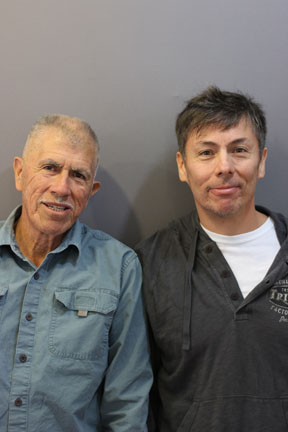April 11, 2016
David and Gilbert Griego

Gilbert: You see the wall exposed, where you can see the beautiful colored minerals. You can see there are changes from one mineral to another. In due time, you see a paradise of minerals. It’s an amazing locality to visit.
David: You really, as a child, grew up at the mine?
Gilbert: Oh yeah. Yeah. During the five working days, they had one day to sort out and bag the minerals. So, that one day, my dad used to take us to the mine. They would let us run in and out of the tunnels, and we ate with the miners, and we just had a good, good time. Of course, at the end of the day, we had to identify some minerals- that was like a school for us. Since there’s 52 different kinds, I mean, we had a lot of identification to do.
David: So, I know one of the stories that I’ve heard from you, as I was growing up, and I think I’ve heard you mention it several times to lot of the young visitors, is the story of the one-eyed mule, Beryl. Can you tell us a little bit about that?
Gilbert: It was amazing. My dad used to say that while they would be working in there, preoccupied with the activities, working inside the tunnels, they would see the mule, Beryl, restless. They would untie the animal, they would untie the straps from the cart he was pulling out, and everybody went out. The following day, there was a cave in. Every time that happened, there was a cave in.
David: He had amazing instincts.
Gilbert: Yeah. Either he had instincts, or he was listening to all the fracture of the cracks that were going on on the ceilings. Or both.
David: So their lives depended on this one-eyed mule.
Gilbert: Oh yes. Very much. The people of Dixon feel like they are part of the mine. Their grandpas and great-grandpas used to work there. They still have some of the minerals that they used to bring home to their families. Some of them even decorated their cemeteries of their loved ones with some of these minerals. So, it’s a part of Dixon. It’s in our backyards and its part of our culture.
Listen to interview